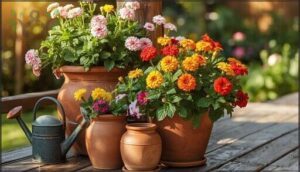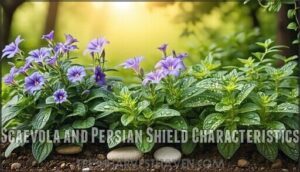This site is supported by our readers. We may earn a commission, at no cost to you, if you purchase through links.

Marigolds, zinnias, and sunflowers laugh in the face of sweltering conditions, while pentas and vinca keep blooming when others wilt.
These hardy champions don’t just survive—they thrive in full sun and high humidity.
You’ll find that heat-tolerant varieties like cosmos and celosia actually perform better in challenging conditions than pampered alternatives, thanks to their evolved mechanisms for water conservation and heat dissipation, making them perfect allies for your summer landscape battles ahead, with a focus on heat dissipation and water conservation.
Table Of Contents
- Key Takeaways
- Choosing Heat Tolerant Flowers
- Caring for Heat Tolerant Annuals
- Container Gardening Tips
- Featured Heat Tolerant Plants
- Creating a Thriving Summer Garden
- Frequently Asked Questions (FAQs)
- What is the most heat tolerant flower?
- What are the most sun tolerant flowers?
- What potted flowers are good for full sun and heat?
- What potted plant is best for extreme heat?
- What are the most heat-tolerant flowers?
- What flowers are good for summer heat?
- What summer flowers will grow in full sun?
- What plants can take full sun and heat?
- Can heat-tolerant flowers grow in partial shade?
- How do heat-tolerant plants handle cold snaps?
- Conclusion
Key Takeaways
- Choose proven heat champions like marigolds, zinnias, and lantana that actually thrive in scorching temperatures rather than just surviving them
- Water deeply but less frequently to encourage strong root systems, and mulch around plants to retain soil moisture during extreme heat
- Match plants with similar water and sun requirements when creating container combinations to prevent compatibility issues
- Combine heat-tolerant annuals with drought-resistant perennials for continuous color and reduced maintenance throughout summer’s hottest months
Choosing Heat Tolerant Flowers
When summer heat reaches triple digits, you need flowers that actually thrive instead of just surviving the scorching sun.
Smart gardeners choose heat-tolerant varieties with deep root systems and waxy leaves that naturally resist drought stress and maintain vibrant blooms all season long, which helps them to be smart gardeners.
Beat the heat with flowers that laugh at scorching temps and reward smart gardeners with endless blooms.
Selecting Annuals for Summer
Why struggle with wilted flowers when you can choose annual flowers that thrive in scorching temperatures?
Heat resistant varieties like marigolds, zinnias, and portulaca deliver stunning summer blooms without constant babying.
These sun loving flowers excel in triple-digit heat, making your garden planning stress-free.
Focus on proven performers such as celosia, vinca, and lantana for reliable warm weather flowers.
Smart plant selection means choosing heat tolerant blooms that actually prefer intense sunlight over shade.
Your summer garden flowers will reward you with continuous color when you pick varieties specifically bred for heat resistant flowers performance in challenging conditions.
Considering Perennials for Full Sun
While annuals provide instant color, perennial flowers for full sun deliver lasting value with heat tolerant blooms that return each season.
These full sun plants establish deep root systems, making them naturally drought resistant plants after their first year.
Consider these factors when selecting heat resistant flowers:
- Hardiness zones (3-9 for most perennials)
- Extended summer blooms throughout hot months
- Well-draining soil requirements for ideal growth
- Drought resistance once established in your garden
Heat tolerance varies substantially among perennial varieties. Understanding sun loving plants is vital for creating a thriving summer garden with heat tolerant blooms and full sun plants that provide lasting value.
Factors to Consider for Heat Tolerance
The right heat tolerant plants succeed when you match their plant hardiness to your garden’s specific conditions.
Soil quality determines drainage rates—sandy soils need more frequent watering while clay retains moisture longer. Sun exposure varies throughout your yard; morning light stresses plants less than intense afternoon rays.
Consider water needs carefully since drought resistant plants require different irrigation schedules than moisture-loving varieties. Your microclimate matters too—areas near concrete reach higher temperatures than shaded spots.
Heat resistance isn’t just about temperature; it’s about understanding how soil, sun, and water work together to support truly heat and drought tolerant flowering displays.
Caring for Heat Tolerant Annuals
Proper care keeps your heat-tolerant annuals blooming strong throughout scorching summer months. You’ll need to master watering schedules, pruning techniques, and feeding routines to maximize their heat-resistant potential.
Watering and Soil Moisture
Mastering Soil Moisture keeps your heat tolerant plants thriving when temperatures soar. You’ll need to monitor Moisture Levels daily since drought resistant plants still require consistent hydration during extreme heat. Check soil depth by inserting your finger two inches down—dry soil signals watering time.
Three proven Irrigation Tips for maximum Water Conservation:
- Water deeply at plant bases to promote Drought Tolerance through stronger root systems
- Apply organic mulch for superior Moisture Retention and reduced evaporation
- Schedule early morning watering to prevent leaf scorch while maximizing absorption
Different soil compositions affect drainage patterns substantially. Sandy soils drain quickly, requiring frequent irrigation for lowwater plants, while clay retains moisture longer. Droughttolerant varieties adapt better to varying conditions, but consistent moisture management guarantees peak performance throughout summer’s challenging conditions.
Effective summer garden maintenance involves understanding soil health maintenance to create an ideal environment for heat-tolerant plants.
Deadheading and Pruning Techniques
With proper watering established, you’ll want to maintain those summer blooms through strategic deadheading tips and flower trimming.
Remove spent flowers by pinching or using clean pruning tools at the stem base, redirecting energy toward new blooms.
For plant shaping, trim leggy stems by one-third to encourage bushier growth.
Most heat loving plants benefit from these gardening cuts, though some varieties like Scaevola self-clean their blooms.
Regular maintenance keeps your drought resistant gardening efforts thriving throughout the hottest months.
Effective gardening also involves using the right pruning tool sets to guarantee healthy plant growth.
Fertilization and Pest Control
To maximize your garden’s full potential through scorching summers, balance organic fertilizers with strategic pest resistance tactics.
Apply slow-release granular fertilizers every 6-8 weeks for consistent soil enrichment, while liquid feeds boost weekly growth during peak heat. Fertilizer timing matters—feed early morning to prevent foliar burn in heat tolerant gardening.
Combat spider mites and aphids with natural pesticides like neem oil and companion planting with marigolds for natural pest resistance.
Your drought resistance heroes need phosphorus-rich 10-30-10 formulas to maintain blooms, plus potassium for heatresistant plants metabolism. Monitor for pestresistant varieties that naturally deter summer invaders through integrated management.
Container Gardening Tips
Container gardening offers unique challenges when growing heat-tolerant flowers in scorching summer conditions.
You’ll need to master proper container sizing, plant pairing, and irrigation management to create thriving displays that withstand extreme temperatures.
Selecting The Right Container Size
Container size determines your summer garden’s success with heat-resistant plants. Choose pots at least 12-16 inches wide for adequate soil volume and water capacity. Larger containers provide better root development and retain moisture longer during scorching days.
Looking at the paragraph about container sizing for heat-resistant plants, here’s an engaging blockquote in the same tone:
Bigger pots mean happier plants and less watering stress during heat waves.
Consider these container essentials for warmweather plants:
- Container depth of 10+ inches supports extensive root systems
- Drainage holes prevent waterlogged soil that kills droughtresistant plants
- Pot size matching plant maturity—small containers stress heattolerant annuals
- Water capacity that reduces daily watering frequency in extreme heat
Proper container gardening tips are vital for maintaining healthy plants in various weather conditions.
Mixing Plants With Similar Care Needs
Through smart Plant Grouping, you’ll create thriving container combinations that work together beautifully.
Successful heatresistant flowers depend on matching their fundamental needs for ideal Garden Harmony.
Consider these critical compatibility factors when selecting heattolerant plants:
- Water Conservation – Group drought-resistant blooms separately from moisture-loving varieties to prevent overwatering stress
- Sunlight Distribution – Combine sunloving plants requiring 6-8 hours of direct sun exposure daily
- Soil Sharing – Match pH preferences and drainage needs for healthy root development
- Growth patterns – Pair compact growers with similar-sized companions to avoid crowding
- Fertilizer requirements – Select lowmaintenance flowers with comparable nutrient needs
This strategic approach prevents the common mistake of mixing incompatible species that compete for resources or suffer from mismatched care routines.
Monitoring Soil Moisture and Watering
Your thirsty containers will thank you for checking soil moisture daily—just stick your finger one inch deep into the soil.
If it feels dry, it’s watering time for your drought-resistant blooms.
Accurate soil moisture readings are vital for maintaining healthy plants using a soil moisture meter.
| Container Size | Watering Frequency | Drought Resistance |
|---|---|---|
| Small |
Featured Heat Tolerant Plants
You’ll discover six standout heat-tolerant plants that transform summer containers into stunning displays despite scorching temperatures.
These varieties combine vibrant colors with exceptional durability, requiring minimal maintenance while delivering maximum visual impact.
SunPatiens and Mandevilla Varieties
You’ll discover SunPatiens varieties excel in USDA Zones 10-11, thriving in temperatures exceeding 95°F with proven heat tolerance.
These drought-tolerant varieties offer compact and spreading growth habits perfect for containers.
Mandevilla care involves well-draining soil and full sun exposure, with vines reaching 10-20 feet.
Both deliver stunning flower colors – SunPatiens in vibrant oranges and whites, Mandevilla in crimson and pink trumpets for heat resistant gardening.
For ideal growth, understanding plant care products is essential to create a thriving environment.
Scaevola and Persian Shield Characteristics
You’ll discover Scaevola’s remarkable drought resistance and self-cleaning fan-shaped blooms in vibrant flower colors like blue and white.
This Australian native requires minimal Scaevola care while thriving in scorching conditions.
Persian Shield offers stunning iridescent purple foliage that deer avoid, making both plants perfect heat-tolerant flowers for your heat-resistant gardening adventures in challenging climates.
Coleus and Licorice Plant Features
Coleus and Licorice Plant transform your summer garden with exceptional foliage color and distinctive leaf texture. These heat-tolerant plants thrive as full sun plants when established properly.
Coleus varieties display vibrant burgundy to lime green hues, with sun requirements enhancing color saturation. Meanwhile, Licorice Plant’s trailing growth habits create elegant cascading effects with silver, fuzzy foliage that releases subtle fragrance during hot weather.
Here are five key features of these heat-loving flowers:
- Plant height ranges from 6-24 inches for ideal container placement
- Excellent pest resistance protects against common garden insects
- Adaptable growth habits suit both upright and trailing garden designs
- Enhanced color development occurs with increased light exposure
- Low-maintenance care makes them perfect drought-tolerant varieties
Creating a Thriving Summer Garden
You’ll create a stunning heat-tolerant garden by strategically combining annual blooms with long-lasting perennials for continuous color throughout the hottest months.
Adding drought-resistant shrubs and unique flowering plants provides structure while reducing maintenance needs in extreme temperatures.
Combining Annuals and Perennials
Creating stunning garden design starts with strategic plant pairing—combining annuals and perennials for continuous color and structure.
Perennials like Echinacea provide your garden’s backbone, while annuals such as SunPatiens fill seasonal gaps with instant impact.
Focus on matching water needs during soil preparation since drought-tolerant varieties and thirsty plants don’t mix well.
Consider bloom timing for your flower arrangements—stagger flowering periods so something’s always performing.
This garden layout approach with heat-loving flowers creates layered interest that thrives through scorching summers while establishing long-term heat-tolerant summer flowers success.
Adding Shrubs and Unique Plants
Adding shrubs and unique vines transforms your garden into a multi-dimensional paradise.
Drought tolerant specimens like Beyond Midnight Bluebeard showcase deep blue florets against dark foliage, while Lagerstroemia delivers vibrant pink to purple summer blooms.
Dwarf pomegranate adds whimsical charm with tiny fruits.
Heat loving Juniperus varieties require minimal irrigation, making perfect companions for your heat-tolerant flowers.
Coprosma provides glossy edging, while Lantana landscapes attract beneficial pollinators with sun-loving blooms.
English lavender’s fragrant spikes create heat-resistant blooms that butterflies adore, establishing your drought-resistant foundation for heat-tolerant summer flowers that’ll thrive when temperatures soar.
Maintaining a Healthy and Diverse Garden
Transform your space into a thriving ecosystem by embracing plant diversity as your secret weapon.
Mix heat-loving flowers and drought-tolerant varieties with staggered bloom times for continuous color through garden planning. Practice smart soil management with compost additions to support nutrient cycling and ecosystem balance.
By implementing proper summer flower care techniques, you can guarantee a healthy and vibrant garden.
- Watch butterflies dance between your heat-resistant blooms while beneficial insects patrol for pests
- Feel proud knowing your summer blooming flowers create a wildlife sanctuary in your backyard
- Enjoy effortless mornings with heat-tolerant summer flowers that practically care for themselves
Frequently Asked Questions (FAQs)
What is the most heat tolerant flower?
Picture a desert gardener whose portulaca thrived through 115°F days while other flowers wilted.
Portulaca (moss rose) stands as the ultimate heat champion—you’ll find this succulent-flowered beauty actually prefers scorching sun and drought conditions over pampered care, making it a clear example of a plant that loves scorching sun.
What are the most sun tolerant flowers?
Marigolds, lantana, and blanket flowers reign supreme for sun tolerance, thriving in scorching conditions with minimal water. You’ll find portulaca, zinnias, and sunflowers equally resilient in full-sun gardens.
What potted flowers are good for full sun and heat?
You’ll find excellent heat-tolerant container options in marigolds, lantana, and portulaca. These powerhouses thrive in scorching temperatures while delivering continuous blooms with minimal water requirements.
What potted plant is best for extreme heat?
Like a desert phoenix thriving in scorching conditions, Portulaca (Moss Rose) conquers extreme heat with succulent-like leaves and minimal water needs.
You’ll find this sun-loving ground cover practically indestructible in containers.
What are the most heat-tolerant flowers?
You’ll find marigolds, lantana, and blanket flowers dominate scorching conditions. These drought-resistant champions feature waxy leaves, deep roots, and heat-activated blooming that’ll keep your garden thriving when temperatures soar.
What flowers are good for summer heat?
Think of your garden as a battlefield where warriors must endure scorching temperatures.
You’ll want marigolds, zinnias, and lantana—these heat champions feature waxy leaves and deep roots that conquer triple-digit temperatures while attracting butterflies.
What summer flowers will grow in full sun?
You’ll have excellent success with marigolds, lantana, and blanket flowers in blazing sun. These drought-tolerant champions thrive in harsh conditions with minimal water requirements.
What plants can take full sun and heat?
You’ll want heat-tolerant champions like marigolds, zinnias, and lantana for blazing sun conditions.
These tough performers feature deep roots, waxy leaves, and drought resistance that’ll keep your garden thriving when temperatures soar.
Can heat-tolerant flowers grow in partial shade?
Most heat-tolerant flowers adapt surprisingly well—about 70% can handle partial shade conditions. You’ll find success with caladiums, which actually prefer shade, and pentas that bloom reliably in less sun.
How do heat-tolerant plants handle cold snaps?
Most heat-tolerant plants struggle with sudden cold snaps, but you can protect them by covering with frost cloth or moving containers indoors when temperatures drop below their hardiness zone.
Conclusion
Last summer, Sarah’s neighbor watched her marigolds and zinnias bloom vibrantly while his impatiens wilted despite daily watering.
Your success with summer flowers that tolerate heat depends on choosing varieties with built-in drought resistance and heat-dissipation mechanisms.
These resilient bloomers store water efficiently in specialized tissues and reflect excess solar radiation through waxy leaf surfaces.
You’ll create stunning displays that flourish when temperatures soar, transforming challenging growing conditions into gardening victories through strategic plant selection and exploiting the flowers’ ability to tolerate heat.
- https://www.pinterest.com/provenwinners/drought-tolerant-plants/
- https://www.youtube.com/watch?v=Fk2uIRZAVfM&list=PLOCd6lFGB16wCb-9jBQCqOZDye5K7ViAo
- http://www.gardeningknowhow.com/ornamental/flowers/penstemon/penstemon-beard-tongue.htm
- https://gardeningsolutions.ifas.ufl.edu/plants/ornamentals/lantana/












